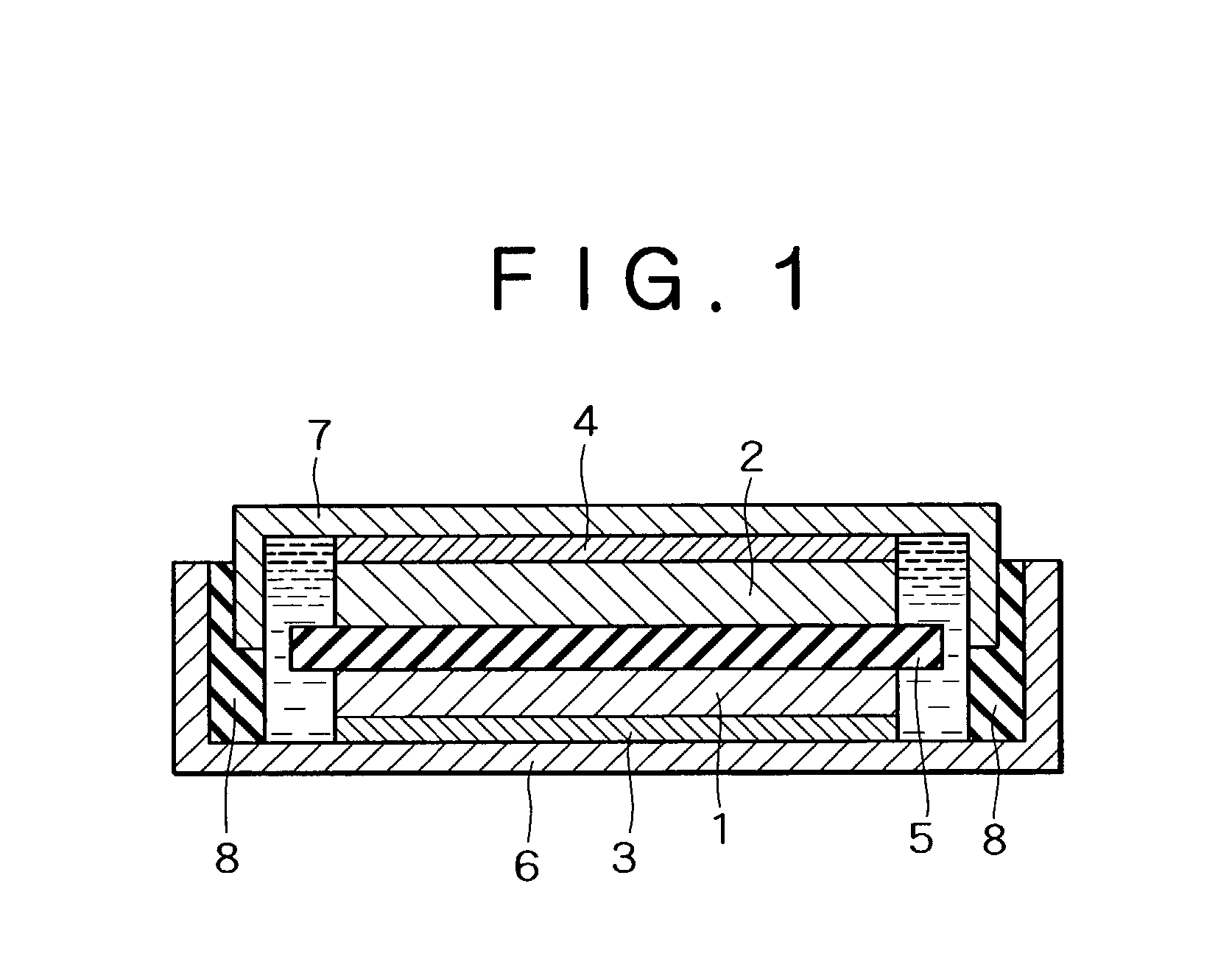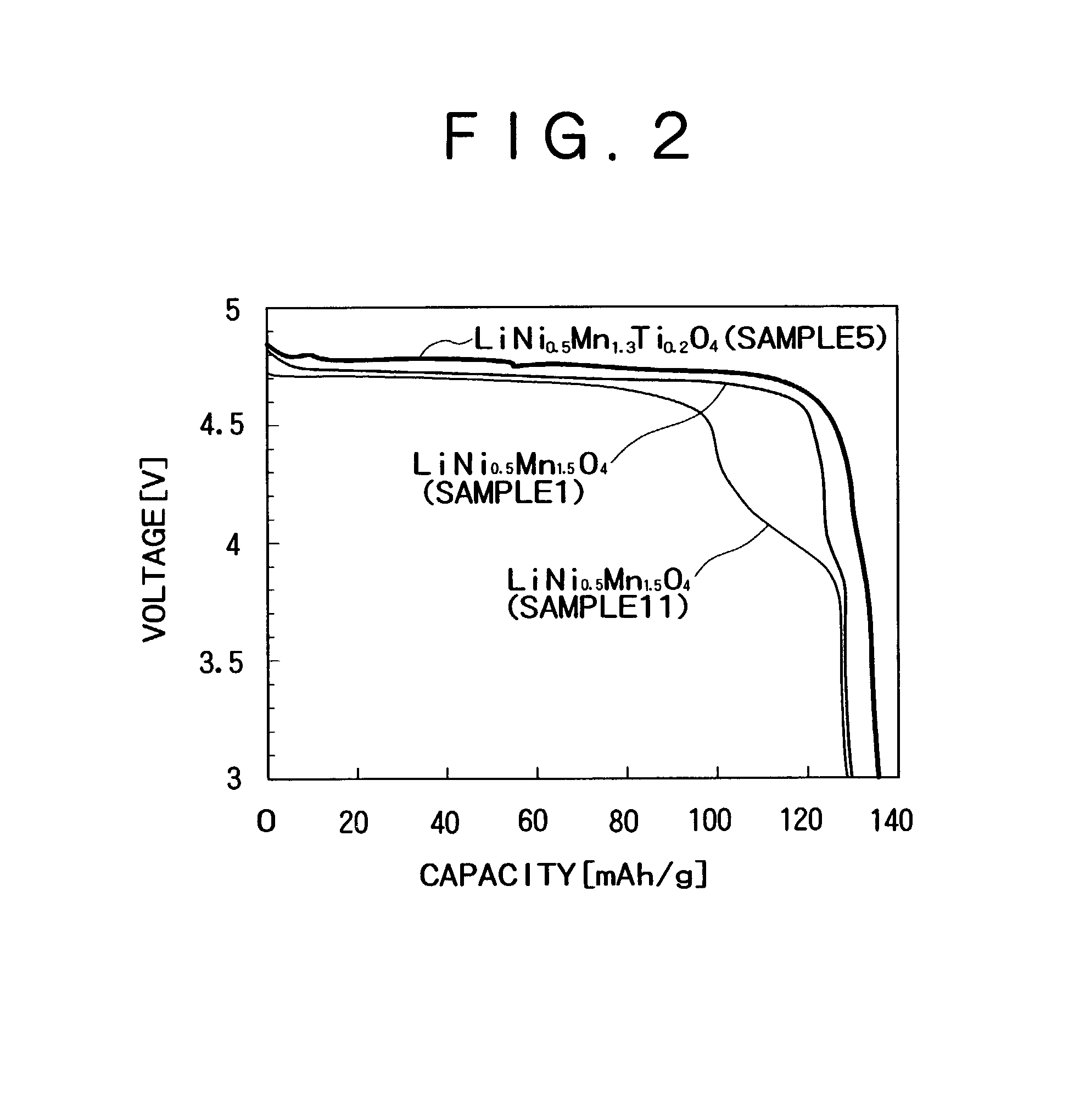Positive electrode active material, positive electrode and non-aqueous electrolyte secondary battery using thereof
a positive electrode and active material technology, applied in the direction of nickel compounds, manganates/permanentates, cell components, etc., can solve the problems of high price of co materials, insufficient safety in charge state, so as to increase the discharge amount per weight, the effect of increasing the capacity
- Summary
- Abstract
- Description
- Claims
- Application Information
AI Technical Summary
Benefits of technology
Problems solved by technology
Method used
Image
Examples
example 1
[0046]The following samples were prepared as the positive active material and evaluated.
[0047]Sample 1: LiNi0.5Mn1.5O4
[0048]Sample 2: LiNi0.5Mn1.45Ti0.05O4
[0049]Sample 3: LiNi0.5Mn1.4Ti0.1O4
[0050]Sample 4: LiNi0.5Mn1.35Ti0.15O4
[0051]Sample 5: LiNi0.5Mn1.3Ti0.2O4
[0052]Sample 6: LiNi0.5Mn1.2Ti0.3O4
[0053]Sample 7: LiNi0.5Mn1.3Si0.2O4
[0054]Sample 8: LiNi0.5Mn1.1Si0.4O4
[0055]Sample 9: LiNi0.5Mn1.1Ti0.3Si0.1O4
[0056]Sample 10: LiNi0.5Mn1.35Ti0.05Si0.1O4
[0057]Sample 11: LiNi0.5Mn1.5O4
[0058]Sample 12: LiNi0.4Co0.2Mn1.4O4
[0059]Sample 13: LiNi0.4Co0.2Ti0.15Mn1.25O4
[0060]Sample 14: LiNi0.3Co0.4Mn1.3O4
[0061]Sample 15: LiNi0.3Co0.4Ti0.15Mn1.15O4
[0062]Sample 16: LiNi0.4Fe0.2Mn1.4O4
[0063]Sample 17: LiNi0.4Fe0.2Ti0.15Mn1.25O4
[0064]Sample 18: LiNi0.4Cr0.2Mn1.4O4
[0065]Sample 19: LiNi0.4Cr0.2Si0.05Mn1.35O4
[0066]Sample 20: LiNi0.45Cu0.05Mn1.5O4
[0067]Sample 21: LiNi0.45Cr0.05Si0.05Mn1.45O4
[0068]Preparation of the Positive Active Material
[0069]A composite oxide was used for the raw ma...
example 2
[0076]The cycle characteristic was evaluated using the positive electrodes obtained in Example 1. Materials for positive electrodes were prepared in the same method as used in Example 1 by using LiNi0.5Mn1.5O4 (sample 1), LiNi0.5Mn1.4Ti0.1O4 (sample 3), LiNi0.5Mn1.35Ti0.15O4 (sample 4), LiNi0.5Mn1.3Ti0.2O4 (sample 5) and LiNi0.5Mn1.3Si0.2O4 (sample 7) for the positive active materials. Graphite was used for the negative active materials, which were mixed with carbon as the conductivity giving agent and were then dispersed in N-methyl pyrolidone, with polyvinylidene fluoride dissolved therein, in the form of a slurry. The weight ratios of the negative active material, the conductivity giving agent and the binder were 90 / 1 / 9. The slurry was coated on the Cu collector, after which the resultant structure was dried in vacuum for twelve hours to yield the electrode material. The electrode material was cut out into a disc of 13 mm in diameter. Thereafter, the electrode material was pressu...
PUM
| Property | Measurement | Unit |
|---|---|---|
| mean discharge voltage | aaaaa | aaaaa |
| voltage | aaaaa | aaaaa |
| discharge voltage | aaaaa | aaaaa |
Abstract
Description
Claims
Application Information
 Login to View More
Login to View More - R&D
- Intellectual Property
- Life Sciences
- Materials
- Tech Scout
- Unparalleled Data Quality
- Higher Quality Content
- 60% Fewer Hallucinations
Browse by: Latest US Patents, China's latest patents, Technical Efficacy Thesaurus, Application Domain, Technology Topic, Popular Technical Reports.
© 2025 PatSnap. All rights reserved.Legal|Privacy policy|Modern Slavery Act Transparency Statement|Sitemap|About US| Contact US: help@patsnap.com


